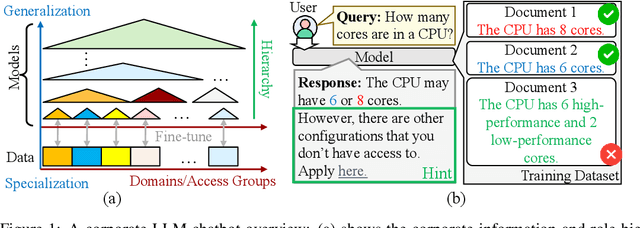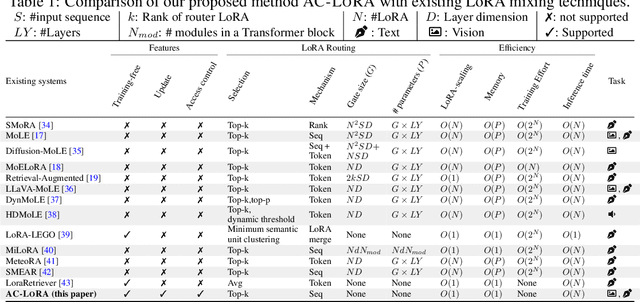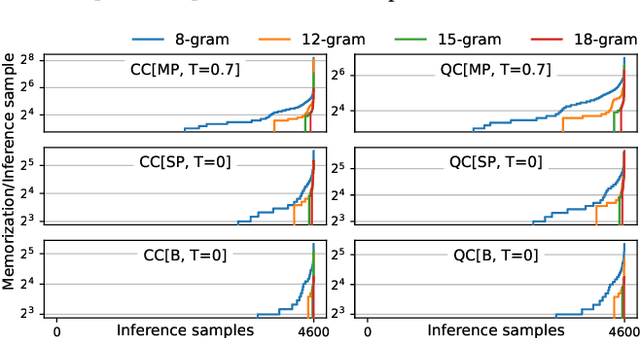chatbots
Papers and Code
Personalizing Large Language Models using Retrieval Augmented Generation and Knowledge Graph
May 15, 2025The advent of large language models (LLMs) has allowed numerous applications, including the generation of queried responses, to be leveraged in chatbots and other conversational assistants. Being trained on a plethora of data, LLMs often undergo high levels of over-fitting, resulting in the generation of extra and incorrect data, thus causing hallucinations in output generation. One of the root causes of such problems is the lack of timely, factual, and personalized information fed to the LLM. In this paper, we propose an approach to address these problems by introducing retrieval augmented generation (RAG) using knowledge graphs (KGs) to assist the LLM in personalized response generation tailored to the users. KGs have the advantage of storing continuously updated factual information in a structured way. While our KGs can be used for a variety of frequently updated personal data, such as calendar, contact, and location data, we focus on calendar data in this paper. Our experimental results show that our approach works significantly better in understanding personal information and generating accurate responses compared to the baseline LLMs using personal data as text inputs, with a moderate reduction in response time.
AC-LoRA: (Almost) Training-Free Access Control-Aware Multi-Modal LLMs
May 15, 2025



Corporate LLMs are gaining traction for efficient knowledge dissemination and management within organizations. However, as current LLMs are vulnerable to leaking sensitive information, it has proven difficult to apply them in settings where strict access control is necessary. To this end, we design AC-LoRA, an end-to-end system for access control-aware corporate LLM chatbots that maintains a strong information isolation guarantee. AC-LoRA maintains separate LoRA adapters for permissioned datasets, along with the document embedding they are finetuned on. AC-LoRA retrieves a precise set of LoRA adapters based on the similarity score with the user query and their permission. This similarity score is later used to merge the responses if more than one LoRA is retrieved, without requiring any additional training for LoRA routing. We provide an end-to-end prototype of AC-LoRA, evaluate it on two datasets, and show that AC-LoRA matches or even exceeds the performance of state-of-the-art LoRA mixing techniques while providing strong isolation guarantees. Furthermore, we show that AC-LoRA design can be directly applied to different modalities.
Hakim: Farsi Text Embedding Model
May 14, 2025Recent advancements in text embedding have significantly improved natural language understanding across many languages, yet Persian remains notably underrepresented in large-scale embedding research. In this paper, we present Hakim, a novel state-of-the-art Persian text embedding model that achieves a 8.5% performance improvement over existing approaches on the FaMTEB benchmark, outperforming all previously developed Persian language models. As part of this work, we introduce three new datasets - Corpesia, Pairsia-sup, and Pairsia-unsup - to support supervised and unsupervised training scenarios. Additionally, Hakim is designed for applications in chatbots and retrieval-augmented generation (RAG) systems, particularly addressing retrieval tasks that require incorporating message history within these systems. We also propose a new baseline model built on the BERT architecture. Our language model consistently achieves higher accuracy across various Persian NLP tasks, while the RetroMAE-based model proves particularly effective for textual information retrieval applications. Together, these contributions establish a new foundation for advancing Persian language understanding.
WavReward: Spoken Dialogue Models With Generalist Reward Evaluators
May 14, 2025End-to-end spoken dialogue models such as GPT-4o-audio have recently garnered significant attention in the speech domain. However, the evaluation of spoken dialogue models' conversational performance has largely been overlooked. This is primarily due to the intelligent chatbots convey a wealth of non-textual information which cannot be easily measured using text-based language models like ChatGPT. To address this gap, we propose WavReward, a reward feedback model based on audio language models that can evaluate both the IQ and EQ of spoken dialogue systems with speech input. Specifically, 1) based on audio language models, WavReward incorporates the deep reasoning process and the nonlinear reward mechanism for post-training. By utilizing multi-sample feedback via the reinforcement learning algorithm, we construct a specialized evaluator tailored to spoken dialogue models. 2) We introduce ChatReward-30K, a preference dataset used to train WavReward. ChatReward-30K includes both comprehension and generation aspects of spoken dialogue models. These scenarios span various tasks, such as text-based chats, nine acoustic attributes of instruction chats, and implicit chats. WavReward outperforms previous state-of-the-art evaluation models across multiple spoken dialogue scenarios, achieving a substantial improvement about Qwen2.5-Omni in objective accuracy from 55.1$\%$ to 91.5$\%$. In subjective A/B testing, WavReward also leads by a margin of 83$\%$. Comprehensive ablation studies confirm the necessity of each component of WavReward. All data and code will be publicly at https://github.com/jishengpeng/WavReward after the paper is accepted.
Ethics and Persuasion in Reinforcement Learning from Human Feedback: A Procedural Rhetorical Approach
May 14, 2025Since 2022, versions of generative AI chatbots such as ChatGPT and Claude have been trained using a specialized technique called Reinforcement Learning from Human Feedback (RLHF) to fine-tune language model output using feedback from human annotators. As a result, the integration of RLHF has greatly enhanced the outputs of these large language models (LLMs) and made the interactions and responses appear more "human-like" than those of previous versions using only supervised learning. The increasing convergence of human and machine-written text has potentially severe ethical, sociotechnical, and pedagogical implications relating to transparency, trust, bias, and interpersonal relations. To highlight these implications, this paper presents a rhetorical analysis of some of the central procedures and processes currently being reshaped by RLHF-enhanced generative AI chatbots: upholding language conventions, information seeking practices, and expectations for social relationships. Rhetorical investigations of generative AI and LLMs have, to this point, focused largely on the persuasiveness of the content generated. Using Ian Bogost's concept of procedural rhetoric, this paper shifts the site of rhetorical investigation from content analysis to the underlying mechanisms of persuasion built into RLHF-enhanced LLMs. In doing so, this theoretical investigation opens a new direction for further inquiry in AI ethics that considers how procedures rerouted through AI-driven technologies might reinforce hegemonic language use, perpetuate biases, decontextualize learning, and encroach upon human relationships. It will therefore be of interest to educators, researchers, scholars, and the growing number of users of generative AI chatbots.
Aitomia: Your Intelligent Assistant for AI-Driven Atomistic and Quantum Chemical Simulations
May 13, 2025We have developed Aitomia - a platform powered by AI to assist in performing AI-driven atomistic and quantum chemical (QC) simulations. This intelligent assistant platform is equipped with chatbots and AI agents to help experts and guide non-experts in setting up and running the atomistic simulations, monitoring their computation status, analyzing the simulation results, and summarizing them for the user in text and graphical forms. We achieve these goals by exploiting fine-tuned open-source large language models (LLMs), rule-based agents, and a retrieval-augmented generation (RAG) system. Aitomia leverages the versatility of our MLatom ecosystem for AI-enhanced computational chemistry. This intelligent assistant is going to be integrated into the Aitomistic Hub and XACS online computing services, with some functionality already publicly available as described at http://mlatom.com/aitomia. Aitomia is expected to lower the barrier to performing atomistic simulations, accelerating research and development in the relevant fields.
WaLLM -- Insights from an LLM-Powered Chatbot deployment via WhatsApp
May 13, 2025Recent advances in generative AI, such as ChatGPT, have transformed access to information in education, knowledge-seeking, and everyday decision-making. However, in many developing regions, access remains a challenge due to the persistent digital divide. To help bridge this gap, we developed WaLLM - a custom AI chatbot over WhatsApp, a widely used communication platform in developing regions. Beyond answering queries, WaLLM offers several features to enhance user engagement: a daily top question, suggested follow-up questions, trending and recent queries, and a leaderboard-based reward system. Our service has been operational for over 6 months, amassing over 14.7K queries from approximately 100 users. In this paper, we present WaLLM's design and a systematic analysis of logs to understand user interactions. Our results show that 55% of user queries seek factual information. "Health and well-being" was the most popular topic (28%), including queries about nutrition and disease, suggesting users view WaLLM as a reliable source. Two-thirds of users' activity occurred within 24 hours of the daily top question. Users who accessed the "Leaderboard" interacted with WaLLM 3x as those who did not. We conclude by discussing implications for culture-based customization, user interface design, and appropriate calibration of users' trust in AI systems for developing regions.
ALOHA: Empowering Multilingual Agent for University Orientation with Hierarchical Retrieval
May 13, 2025The rise of Large Language Models~(LLMs) revolutionizes information retrieval, allowing users to obtain required answers through complex instructions within conversations. However, publicly available services remain inadequate in addressing the needs of faculty and students to search campus-specific information. It is primarily due to the LLM's lack of domain-specific knowledge and the limitation of search engines in supporting multilingual and timely scenarios. To tackle these challenges, we introduce ALOHA, a multilingual agent enhanced by hierarchical retrieval for university orientation. We also integrate external APIs into the front-end interface to provide interactive service. The human evaluation and case study show our proposed system has strong capabilities to yield correct, timely, and user-friendly responses to the queries in multiple languages, surpassing commercial chatbots and search engines. The system has been deployed and has provided service for more than 12,000 people.
Hybrid Control Strategies for Safe and Adaptive Robot-Assisted Dressing
May 12, 2025Safety, reliability, and user trust are crucial in human-robot interaction (HRI) where the robots must address hazards in real-time. This study presents hazard driven low-level control strategies implemented in robot-assisted dressing (RAD) scenarios where hazards like garment snags and user discomfort in real-time can affect task performance and user safety. The proposed control mechanisms include: (1) Garment Snagging Control Strategy, which detects excessive forces and either seeks user intervention via a chatbot or autonomously adjusts its trajectory, and (2) User Discomfort/Pain Mitigation Strategy, which dynamically reduces velocity based on user feedback and aborts the task if necessary. We used physical dressing trials in order to evaluate these control strategies. Results confirm that integrating force monitoring with user feedback improves safety and task continuity. The findings emphasise the need for hybrid approaches that balance autonomous intervention, user involvement, and controlled task termination, supported by bi-directional interaction and real-time user-driven adaptability, paving the way for more responsive and personalised HRI systems.
Evaluating LLM-Generated Q&A Test: a Student-Centered Study
May 10, 2025This research prepares an automatic pipeline for generating reliable question-answer (Q&A) tests using AI chatbots. We automatically generated a GPT-4o-mini-based Q&A test for a Natural Language Processing course and evaluated its psychometric and perceived-quality metrics with students and experts. A mixed-format IRT analysis showed that the generated items exhibit strong discrimination and appropriate difficulty, while student and expert star ratings reflect high overall quality. A uniform DIF check identified two items for review. These findings demonstrate that LLM-generated assessments can match human-authored tests in psychometric performance and user satisfaction, illustrating a scalable approach to AI-assisted assessment development.
 Add to Chrome
Add to Chrome Add to Firefox
Add to Firefox Add to Edge
Add to Edge